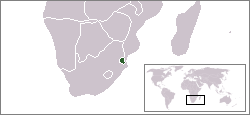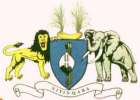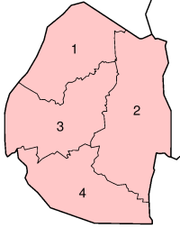Swaziland
|
|
The Kingdom of Swaziland is a small country in southern Africa (one of the smallest on the continent), situated on the eastern slope of the Drakensberg mountains, embedded between South Africa in the west and Mozambique in the east. The country is named after the Swazi, a Bantu tribe.
| |||||
| National motto: Siyinqaba (Swati: We are the fortress) | |||||

| |||||
| Official language | Swati and English | ||||
| Capitals | Mbabane: administrative Lobamba: royal and legislative | ||||
| King | Mswati III | ||||
| Indovuzaki | Queen Ntombi | ||||
| Prime Minister | Themba Dlamini | ||||
| Area - Total - % water | Ranked 153rd 17,363 km² 0.9% | ||||
| Population - Total (2001) - Density | Ranked 151st 1,104,343 65/km² | ||||
| Independence | September 6, 1968 | ||||
| Currency | Lilangeni | ||||
| Time zone | UTC + 2 | ||||
| National anthem | Nkulunkulu Mnikati wetibusiso temaSwati | ||||
| Internet TLD | .sz | ||||
| Calling Code | 268 | ||||
| Contents |
History
Main article: History of Swaziland
Human remains and artifacts from more than 100,000 years ago have been found in Swaziland. Evidence of agriculture and iron use dates from about the 4th century, and people speaking languages ancestral to current Sotho and Nguni languages began settling no later than the 11th century. The ruling Dlamini lineage had chiefships in the region in the 18th century. An enlarged Swazi kingdom was established by Sobhuza I in the early 19th century. Soon thereafter the first whites started to settle in the area. In the 1890s the South African Republic in the Transvaal claimed sovereignty over Swaziland but never fully established power. After the South African War of 1899-1902, Swaziland became a British protectorate. The country was eventually granted independence on September 6, 1968. Since then, Swaziland has seen a struggle between pro-democracy activists and the totalitarian monarchy.
Politics
Main article: Politics of Swaziland
The head of state is the king, which since 1986 has been King Mswati III. By tradition, the king reigns along with his mother (the Indovuzaki, lit. Great She-Elephant), the former viewed as the administrative head of state and the latter as a spiritual and national head of state. As the monarch, the king not only appoints the prime minister – the head of government – but also appoints a small number of representatives for both chambers of the Libandla (parliament). The Senate consists of 30 members, while the House of Assembly has 65 seats, 55 of which are occupied by elected representatives (elections are held every 5 years in November).
The 1968 constitution was suspended in 1973 in a State of Emergency decree still in force today. In 2001 King Mswati III appointed a committee to draft a new constitution. Drafts were released for comment in May 2003 and November 2004. However they were strongly criticised by civil society organizations in Swaziland and human rights organisations elsewhere.
King Mswati III is often critisized for living so lavishly in a nation that is afflicted by one of the worlds highest HIV infection rates. His fleet of luxury cars, millions spent towards refurbishing his numerous wives' luxury mansions, are at odds with 40 percent of the nation that stand unemployed, nearly 70 percent of which live on less than a dollar a day, and with 40 percent of adults who are afflicted by HIV.
Districts
Main article: Districts of Swaziland
Swaziland is divided into four districts:
Geography
Main article: Geography of Swaziland
Swaziland offers a wide variety of landscapes, from the mountains along the Mozambican border to savannas in the east and rainforest in the northwest. Several rivers flow through the country, such as the Lusutfu River. With 50,000 inhabitants, the capital city - Mbabane - is the largest town in the nation; others include Manzini, Lobamba and Siteki.
Economy
Main article: Economy of Swaziland
In this small, landlocked economy, subsistence agriculture occupies more than 80% of the population. The manufacturing sector has diversified since the mid-1980s. Sugar and wood pulp remain important foreign exchange earners. Mining has declined in importance in recent years with only coal and quarry stone mines remaining active. Surrounded by South Africa, except for a short border with Mozambique, Swaziland is heavily dependent on South Africa from which it receives nine-tenths of its imports and to which it sends more than two-thirds of its exports. Customs duties from the Southern African Customs Union and worker remittances from South Africa substantially supplement domestically earned income. The government is trying to improve the atmosphere for foreign investment. Overgrazing, soil depletion, drought, and sometimes floods persist as problems for the future. More than one-fourth of the population needed emergency food aid in 2002 because of drought, and more than one-third of the adult population was infected by HIV. 2004 Swaziland acknowledges for the first time that it has one of the highest AIDS rates in the world, with almost 40% of adults infected with HIV. Prime Minister Themba Dlamini has declared a humanitarian crisis due to the combined effect of drought and land degradation, increasing poverty and HIV/AIDS. The United Nations special envoy on AIDS Stephen Lewis said “Swaziland stands alone with the world's highest rate of HIV infection after nearby Botswana made headway against the deadly pandemic.”
Demographics
Main article: Demographics of Swaziland
The majority of the population consists of Swazi, but there are also small numbers of Zulu, Europeans and Mozambican refugees. The official languages are Swati and English; the latter is also the official written language. The chief religion is Christianity, often in a form blended with several indigenous religions. There are also Jewish and Muslim communities.
Culture
Main article: Culture of Swaziland
Miscellaneous topics
- Communications in Swaziland
- Transportation in Swaziland
- Military of Swaziland
- Foreign relations of Swaziland
- List of cities in Swaziland
- Dream for Africa
- Never Ending Gardens
- AIDS in Africa
- Reporters without borders Worldwide Press Freedom Index 2002: Rank 89 out of 139 countries (3 way tie)
External links
Template:Portal Template:Commonscat Template:Wiktionary
Government
- Swaziland Government (http://www.gov.sz/) official government site
- Ministry of Tourism (http://www.mintour.gov.sz/) official site
News
- allAfrica - Swaziland (http://allafrica.com/swaziland/) news headline links
- Times of Swaziland (http://www.times.co.sz/) newspaper
Overviews
- BBC News - Country Profile: Swaziland (http://news.bbc.co.uk/1/hi/world/africa/country_profiles/1069035.stm)
- CIA World Factbook - Swaziland (http://www.cia.gov/cia/publications/factbook/geos/wz.html) data as of May 1996
Directories
- LookSmart - Kingdom of Swaziland (http://search.looksmart.com/p/browse/us1/us317836/us317916/us559898/us559899/us10065675/us559956) directory category
- Open Directory Project - Swaziland (http://dmoz.org/Regional/Africa/Swaziland/) directory category
- Stanford University - Africa South of the Sahara: Swaziland (http://www-sul.stanford.edu/depts/ssrg/africa/swazi.html) directory category
- University of Pennsylvania - African Studies Center: Swaziland (http://www.sas.upenn.edu/African_Studies/Country_Specific/Swaziland.html) directory category
- Yahoo! - Swaziland (http://dir.yahoo.com/Regional/Countries/Swaziland/) directory category
Tourism
Other
- Online documentary about King Mswati III (http://www.insightnewstv.com/d78)
- Matsapha Airport information (http://www.people.freenet.de/copilot/Matsapha-eng.htm)
| Countries in Africa | ||
|
Algeria | Angola | Benin | Botswana | Burkina Faso | Burundi | Cameroon | Cape Verde | Central African Republic | Chad | Comoros | Democratic Republic of the Congo | Republic of the Congo | Côte d'Ivoire | Djibouti | Egypt | Equatorial Guinea | Eritrea | Ethiopia | Gabon | The Gambia | Ghana | Guinea | Guinea-Bissau | Kenya | Lesotho | Liberia | Libya | Madagascar | Malawi | Mali | Mauritania | Mauritius | Morocco | Mozambique | Namibia | Niger | Nigeria | Rwanda | São Tomé and Príncipe | Senegal | Seychelles | Sierra Leone | Somalia | Somaliland | South Africa | Sudan | Swaziland | Tanzania | Togo | Tunisia | Uganda | Zambia | Zimbabwe | Western Sahara | ||
| Dependencies: Canary Islands | Ceuta and Melilla | Madeira Islands | Mayotte | Réunion | Saint Helena and dependencies | ||
ar:سوازيلند ca:Swazilàndia de:Swasiland es:Swazilandia eo:Svazilando fr:Swaziland gd:Swaziland gl:Suacilandia - Swaziland ko:스와질란드 hi:स्वाजीलैंड io:Swazilando id:Swaziland it:Swaziland he:סווזילנד lv:Svazilenda lt:Svazilandas ms:Swaziland zh-min-nan:Swazi-tē nl:Swaziland nds:Swasiland ja:スワジランド no:Swaziland pl:Suazi pt:Suazilândia ro:Swaziland ru:Свазиленд sa:स्वाजीलैंड sk:Svazijsko sl:Svazi fi:Swazimaa sv:Swaziland tr:Svaziland uk:Свазиленд zh:斯威士兰



